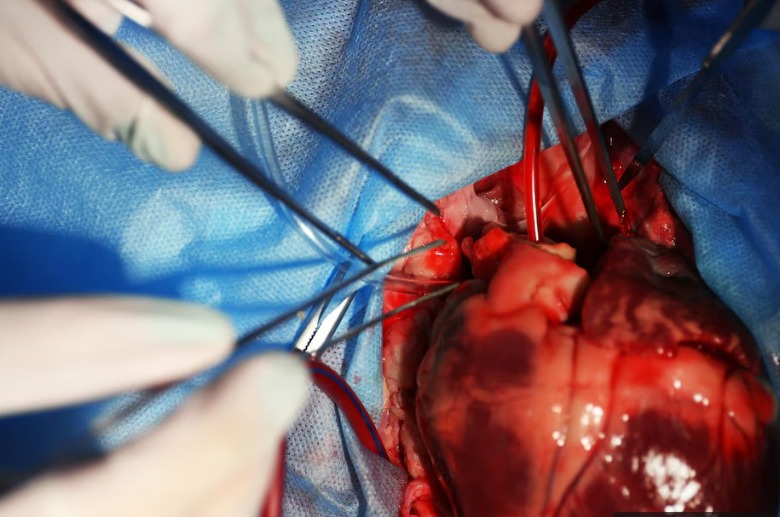For those who suffer from irregular heart rhythms, a condition that impacts millions of people in a variety of demographics, heart pacemaker surgery is becoming an increasingly important procedure. In this procedure, a pacemaker—a tiny electronic device—is implanted beneath the skin, usually on the left sides of the chest, close to the collarbone. Its main function is to control erratic heartbeats so that the heart keeps a healthy rhythm. The procedure, which typically takes about an hour and is frequently done as an outpatient, is remarkably effective and minimally invasive.
While local anesthesia numbs the place where the incision will be made, the patient is first sedated to reduce any anxiety. To reach the veins, the surgeon carefully makes a tiny incision close to the collarbone, typically 5–6 cm long. The surgeon inserts the pacemaker’s leads—thin wires—into the heart using X-ray imaging. When positioned properly, these leads enable the pacemaker to track the heart’s rhythm and deliver the electrical impulses required to sustain a regular heartbeat. Once the leads are secured, the pacemaker generator is placed in a tiny pocket made beneath the skin. The incision is sutured up after the leads are connected to the generator, and the pacemaker’s operation is examined to make sure it is operating as planned.
| Bio Information | Details |
|---|---|
| Full Name | Heart Pacemaker Surgery |
| Procedure Length | Approximately 1 hour |
| Type of Surgery | Minimally invasive, outpatient |
| Common Placement | Below the collarbone, left side of chest |
| Aftercare | Hospital stay of 1-2 days |
| Recovery Time | Normal activities resumed in a few days, strenuous activities avoided for 2-3 weeks |
| Main Risks | Infection, bleeding, blood clots, device malfunction |
| Key Benefits | Regulates heart rhythm, alleviates symptoms of arrhythmias, prevents fainting and complications from irregular heartbeats |
| Procedure Guide | Mayo Clinic – Pacemaker Surgery |
The majority of patients will stay in a hospital for one to two days following surgery in order to be observed. Compared with more invasive heart surgeries, the recovery process is noticeably faster, and most patients are able to resume their regular activities in a matter of days. To give the body time to heal completely, patients are advised to refrain from strenuous activity for a few weeks. Follow-up appointments are also essential to track the pacemaker’s continued operation and make sure there are no issues.

The method of controlling cardiac rhythms has been further transformed by the introduction of leadless pacemakers. Leadless pacemakers are placed directly into the heart through a catheter that is inserted through a blood vessel, usually in the groin area, as opposed to conventional pacemakers, which need wires to connect the device to the heart. For patients who only need pacing in one chamber of the heart, this approach provides a more efficient course of treatment, speeds up recovery, and significantly lowers the risk of complications. Patients with specific arrhythmias, in which the need for pacing is limited to a single heart chamber, have shown particular benefit from leadless pacemakers.
Pacemaker surgery still carries some risks in spite of these advancements. Complications are uncommon, but they can still happen. Blood clots, infection, bleeding, and pacemaker device malfunction are possible risks. Additionally, there is a chance that the pacemaker itself could malfunction or the leads could come loose. Thankfully, these risks have been greatly decreased by pacemaker technology advancements, making the procedure safer than ever. Patients must also follow aftercare instructions, particularly with regard to specific external devices like security scanners and MRI machines that may interfere with the pacemaker’s operation. To make sure the pacemaker is functioning properly and to check on its battery life, routine follow-up visits are required.
The impact of pacemaker technology on society increases as it develops further. For people with heart arrhythmias and associated complications, pacemaker surgery has become a lifesaver, and heart disease continues to rank among the world’s leading causes of death. Prominent people, like former athlete Chris Berman, have openly discussed their pacemaker surgery experiences, promoting awareness of heart health and the potentially life-saving nature of these devices. By emphasizing that even the most well-known people can develop heart problems, their readiness to talk candidly about their experiences has greatly helped to dispel the stigma associated with heart problems.
Further developments in pacemaker technology have also been spurred by the continuous need for heart health solutions. These devices are constantly being improved by cardiologists and researchers to become even more dependable, more compact, and more efficient. Innovations brought about by the increased interest in pacemakers have improved their effectiveness and accessibility for a wider variety of patients. New pacemaker models, for instance, have improved battery life and durability, allowing patients to go longer between replacements—a major advancement in patient care.
A cultural shift toward proactive healthcare has also been facilitated by the growth of wearable heart health technologies. Since pacemakers enable people to maintain a higher quality of life in addition to helping to regulate heart rhythm, they are now essential to this movement. Pacemakers enable patients to live their lives without the continual fear of heart failure or sudden cardiac arrest by preventing fainting and other dangerous heart rhythm abnormalities. Pacemaker surgery has thus evolved from a simple medical procedure to an essential part of managing one’s own health.
